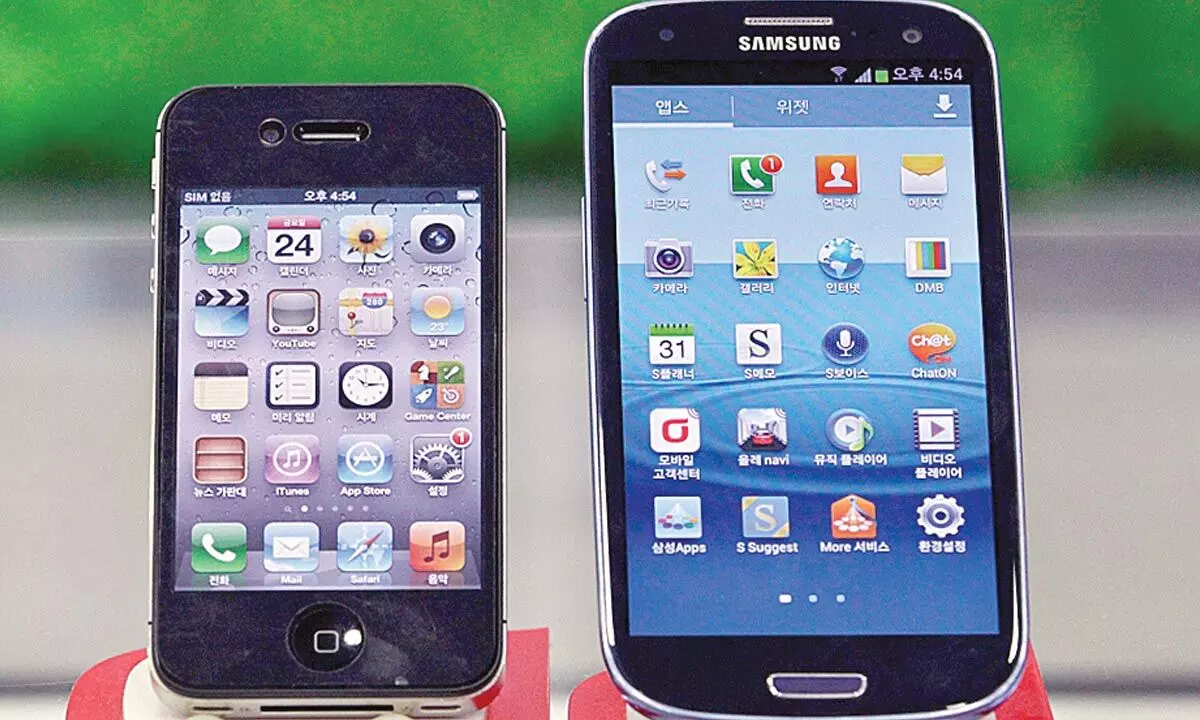Apple cashing in on the mobile phone exports bonanza
Orchestra grows for manufacture of domestic components
image for illustrative purpose

Another issue is the level of investments under the PLI scheme for electronics, which has so far been less than Rs. 5000 crore. This needs to be ramped up considerably. On the plus side, even this level of investment has led to a remarkable five-fold rise in mobile phones production
Even as challenges facing exports in the coming year are quite worrisome, mobile phone exports have shot up in 2022-23. These have doubled to $11.2 billion compared to $5.8 billion in the previous financial year. A notable aspect is that almost $ five billion worth of exports are iPhones made by Apple while Samsung accounts for another $four billion. This bonanza makes mobile phones the fastest growing segment in the country’s export basket. This spurt comes parallel to the downslide of outbound trade.
Currently petroleum products have a large share along with gems and jewellery but it seems that mobile phones will be a major export sector in the coming five years.
This is welcome news as export growth showed signs of reaching a plateau over the past six months. Official data for the first 11 months of the current fiscal shows that exports rose to $405.94 billion compared to $377.43 billion over the same period in the previous fiscal. The increase has largely been in petroleum products, gems and jewellery while the other sectors have remained stagnant. The slowdown in exports began last October when a dip of 16.7 per cent was recorded and this was followed by a fall of three per cent in December and 8.8 per cent in February. Approximately, 16 of the country’s top export products registered declining trends.
The situation is not expected to improve significantly in 2023 as external headwinds are likely to affect exports. These include the Ukraine war, high inflation and monetary tightening policies. Demand has already begun cooling down compared to 2021-22 when the post-pandemic pent up demand had led to exports rising to record levels of over $400 billion.
Amid this backdrop, it is clear that mobile phones exports are moving contrary to trends in most other sectors. The success story scripted by Apple and Samsung shows that the production-linked incentive scheme (PLI) has made a difference. The scheme was launched initially for electronic goods but has now been extended to 13 other industries. Under the PLI system, manufacturers are given incentives on sales of products. The twin aims of the scheme are to increase indigenous production of components as well as to create more jobs.
One of the criticisms of the scheme in the case of mobile phones has been that Indian units are only assembling components that are imported. There is no doubt this is the way in which most units started out but the situation is now changing and domestic production of components has increased greatly.
In fact, ICRA, in a study published last year, found that domestic sourcing of components is set to rise from 15 to 20 per cent to 35 to 40 per cent by 2026.
Another issue is the level of investments under the PLI scheme for electronics, which has so far been less than Rs. 5000 crore. This needs to be ramped up considerably. On the plus side, even this level of investment has led to a remarkable five-fold rise in mobile phones production from six crore in 2014-15 to about 31 crore in 2021-22..
But it looks like the volume of investments will go up substantially as Foxconn, manufacturer of Apple iPhones, is launching a new project shortly in Karnataka. A proposal for a Rs. 8,000 crore greenfield mobile phone manufacturing unit near Bengaluru has just been cleared by the state government. It will be Foxconn’s largest manufacturing facility in the country and it is expected to generate 50,000 jobs. Other collaborators of the Big Tech company such as Wistron and Pegatron have also set up production units in Tamil Nadu along with Foxconn and have reportedly created 1.5 lakh jobs.
One reason that Apple and other tech giants like Samsung have put their faith in this economy is the existence of a large domestic market, as is the case with China. But India has been a price-sensitive market and premium products like iPhone, iPad and Mac laptops were not finding as much demand in the face of competition from cheaper products. The situation is now changing gradually with the company adopting a more aggressive marketing strategy.
Samsung, on the other hand, has found a more responsive mass consumer base, owing to the wider price range of its products. Besides, it has been here for a much longer period and is an entrenched player not just in mobile phones but in consumer goods sector, as well. But India has now emerged as a hub for exports for both multinational manufacturers of mobile phones.
The mobile phones sector thus needs to be given even greater support in terms of infrastructure and continuation of the PLI scheme. At the same time, it is essential to ensure that domestic production of components and accessories is expanded as far as possible to avoid creating only assembly units. Thus both higher investments and greater innovation need to be encouraged in the domestic electronics industry.

